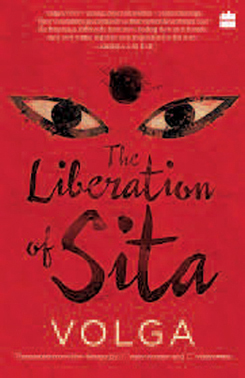Volga’s The Liberation of Sita talks about how patriarchy harms not only women, but also assigns set roles for men, thus shackling them as well.
VOLGA’s, The Liberation of Sita is a feminist look at Sita via minor female characters in the Ramayana. It says so right there in the blurb at the back of the book, so you think you know what to expect when you start to read it. After all, no woman has liked the end of the Ramayana, when Rama sends his wife Sita to the jungle because gossip in Ayodhya implies she was not faithful to him. For Rama, an emperor’s duty is to his citizens first. Even his beloved wife comes second.
But a few pages into the book, you know that this novel, told via six episodes, gives you far more than a simple feminist retelling of familiar tales. Volga’s liberated Sita has to learn her lessons: enlightenment doesn’t simply arise. She begins with faith in selflessness and then, via her own experiences and those of other women, comes to have faith in herself alone. It’s an extraordinary journey and I cannot explain, however hard I try, how light and burden-free it makes you feel by the end.
We all know that Sita is the epitome of chaste womanhood, a woman who lived for Rama alone. Certainly that’s how she is when Volga’s book begins, but she’s no mindless doll. There are things she wonders about, and asks Rama to explain, questions she wants answered, even when Rama or her in-laws gently turn her mind away from matters they believe pure Sita ought not to have on her mind.

But Sita is curious and compassionate, so although Rama does not want to talk about Ahalya, for sixth episode in the book, after Sita is truly liberated, is about Rama, and tellingly, is titled “The Shackled”. Rama, we learn, is locked in place by his role as the propagator of Arya Dharma, and he doesn’t even know he’s in chains. All he knows is that, without Sita, instance, referring to her as a woman of poor character, Sita is determined to know what happened the day Ahalya’s husband, the sage Gautama, cursed her and turned her to stone, and more important, what Ahalya has been doing since.
She’s also curious about Renuka (the sage Jamadagni’s wife who was decapitated by her son, Parushurama), Surpanakha (Ravana’s sister, who had her nose and ears cut off by Rama for trying to lure him from Sita), and Urmila (her sister and Lakshmana’s wife, who had been left behind in Ayodhya without even a discussion when Rama was exiled to the jungle for 14 years), and learns from them over the years how they turned humiliation into deep inner strength — strength that Sita herself possesses, although she does not yet know or understand it.
I cannot explain how stunning the stories are. Reading about these women and the injustice they have been subject to, coming to understand along with them, as they tell Sita their stories, what is important and what is merely ephemeral, these are powerful stories, and they are told in the simplest way possible.
But this is not simple feminism of the “men are responsible for all the evil in the world” type. This is true feminism -that is to say, person-ism. While Volga certainly makes strong statements about the patriarchal nature of Indian society, she also shows how patriarchy binds men into roles, just as it binds women. The he is deeply unhappy, but still, his duty must be done.
This is why I urge not only women to read this book. It’s not “feminism” for women. It’s personhood for all people. And it must, must be read.
The Swiss Swami’s magic
A CHANCE ENCOUNTER, with Swami Jnananandaji in Mussoorie in the early 1980s left an indelible impact on the author, who then picked up his pen to jot down his personal journey post-meeting his friend, philosopher and guide in the “Swiss Swami”, as Swami Jnananandaji was lovingly called.
What started off as a personal collection of thoughts, words of wisdom, discussions, and anecdotal incidents finally took the shape of a 125-page book, after the passing away of the Swami in November, 2015.
Light humorous moments in simple spoken English makes it an interesting read, leaving the reader with a smile on their lips as at some point in the book they empathize with the author, making his journey, their own.
The forgotten hero
SPITFIRE SINGH, is a biography of Late Air Vice Harjinder Singh by Mike Edwards. What truly stands out is the manner in which Mike has presented Harjinder. It is a most readable thriller woven around the evolution of a lowly Hawai Sepoy to an Air Vice Marshal. A Sepoy was, perhaps, the lowliest rank showered on the Indian members of the erstwhile air force (RAF) serving under the British crown, which eventually found its way in the somewhat Indianised formation of Royal Indian Air Force (RIAF). It reflected the level of contempt at which the British personnel of the RAF held their Indian counterparts.

Despite these odds against him, Harjinder rose to monumental heights of achievement. The disdain, perhaps, catalysed to challenge.
With a measure of regret, I must say that we seem to have forgotten Harjinder’s support to the Indian Air Force and the nation throughout his life till his early death in 1963. I most earnestly recommend a thorough reading of this book by not merely aviators but also by people who are protagonists of development, building organisations and visions for a future. Mike brings these path-breaking success stories to his readers with great felicity in a superb text.
